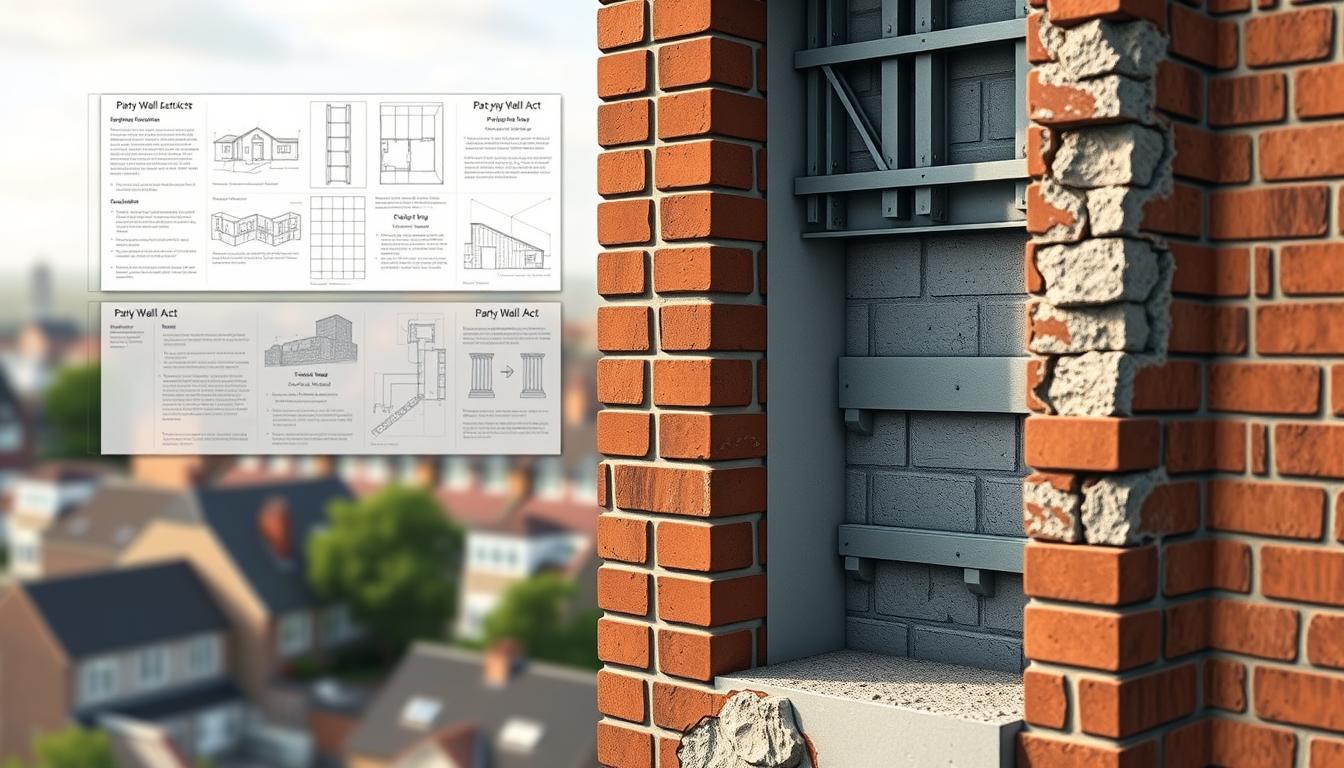Are you looking to begin a home improvement project but have to contend with the Party Wall Act 1996? You’re not alone. Understanding your rights and responsibilities when working near shared boundaries or partywalls in England and Wales can feel overwhelming. That’s where the Party Wall Act 1996 comes in – and we’re here to decode it for you.
You might be planning a loft conversion or repairing a shared chimney, and so this law affects you. It’s designed to prevent disputes by setting clear terms for notifying neighbours and managing building work. However, official guidance documents aren’t exactly easy to understand. How do you know when you need to serve a notice? What happens if your neighbour disagrees?
Take Sarah from Bristol, who nearly delayed her extension by six months because she didn’t understand the Party Wall Act and was late in serving notice. Or, David in Cardiff, who avoided costly legal fees by following the right procedures. Their stories show why getting this right matters.
Key Takeaways
- The Act applies to building work affecting shared walls, boundaries, or excavations near neighbouring properties
- Homeowners must serve written notices to neighbours – verbal agreements aren’t enough
- Disputes are resolved through surveyor appointments, not immediate court action
- Guidance from RICS and government booklets helps navigate the process
- Timing matters – start discussions at least 1-2 months before work begins
We’ll walk through real-life examples and plain-English explanations of the Act 1996, using trusted sources like the Ministry of Housing’s practical guides. By the end, you’ll feel ready to handle those partywall conversations with confidence.
Introduction to the Party Wall Act 1996
Did you know that your home improvements could legally involve the person next door? The Party Wall Act exists to protect both your rights and your neighbour’s when work affects shared structures. Let’s break down what this means in practice.
Purpose of the Act
This legislation and the surveyors involved act like a referee in property disputes. It stops arguments before they progress to your local county court by setting clear rules for building near shared boundaries. As the government booklet states: “The Act provides a framework for preventing and resolving disagreements without costly legal battles.”
Think of it as a conversation starter. Whether you’re cutting into a shared wall or excavating near a boundary, the rules ensure everyone’s interests are taken into account.
Who is Affected
Two main roles exist under the Act:
| Building Owner | Adjoining Owner |
|---|---|
| Person carrying out works | Neighbour affected by works |
| Must serve written notice | Has right to request surveys |
| Covers shared walls/floors | Wants their property protected from damage |
You become a building owner if you’re planning:
- New walls on boundaries
- Loft conversions affecting party walls
- Basements near neighbouring foundations
Key fact: You must serve notices at least 1-2 months before work starts – even if your neighbour seems supportive. They must also respond in writing, otherwise they are deemed to have dissented. Are you clear which role applies to your project?
Understanding the Party Wall Act 1996
What gives the Party Wall Act its teeth? This framework balances neighbourly relations with building rights through specific rules. Let’s peel back the layers to see how it operates day-to-day.
The Legal Framework
The Act works like a three-step safety net. First, it requires formal notices. Second, it allows for professional surveys. Third, it establishes dispute resolution through appointed surveyors. As the Ministry’s guidance states: “The law prioritises prevention over cure in neighbour disputes.”
This structure applies to:
- Cutting into shared walls for beam supports
- Demolishing/reconstructing party structures
- Excavating within 3 metres of neighbouring foundations
Key Provisions Overview
Four main rules protect both sides:
- Works causing structural impact require consent or surveyor involvement
- Neighbours can request protective measures such as low-vibration tools
- Surveyors determine fair compensation for damages
- Building owners must cover all surveyor fees
Remember: The Act doesn’t replace planning permission. You might need both approvals. A loft conversion could meet building regulations but still require partywall agreements.
Take the case of a London homeowner who installed steel beams without following due process. Their neighbour successfully claimed £8,000 for crack repairs through the Act’s provisions. Could your project benefit from this protective framework?
Exploring Party Walls: Definitions and Types
Ever stared at a partywall and questioned its legal status? Many homeowners confuse party structures with simple boundary features. Let’s clear up the confusion using official definitions from the government guidelines.
Distinguishing Party Walls from Boundary Walls
The key difference lies in ownership and purpose. A party wall sits astride the boundary line between two properties, serving both buildings. In contrast, a boundary wall usually stands entirely on one owner’s land.
| Feature | Party Wall | Boundary Wall |
|---|---|---|
| Ownership | Shared by different owners | Single owner |
| Construction | Built astride boundary | On one side of legal boundary |
| Legal Treatment | Protected under the Act | General property law or common law |
Walls built astride the boundary automatically qualify as party structures or partywalls. Think of semi-detached homes sharing a central wall – this classic example shows how one structure serves two separate buildings.
Ownership matters too. A garden wall becomes a party fence wall if it sits astride the line of junction. The Act only applies when work potentially affects neighbouring structures.
Need help identifying your wall type? Our guide on what constitutes a party wall breaks down real-world scenarios. Remember: even excavating near a boundary could trigger the Act’s requirements if it risks neighbouring foundations.
When Does the Party Wall Act Apply?
What exactly invokes Party Wall Act requirements? The answer lies in the type of work you’re planning. Let’s explore which projects need formal notifications and why.
Identifying Relevant Building Works
The Act springs into action for specific structural changes. Government guidance lists these key triggers for partywalls:
| Work Type | Examples | Notice Required? |
|---|---|---|
| New construction | Building on boundary lines | Yes |
| Modifications | Cutting into shared walls | Yes |
| Excavations | Digging near foundations | Yes (within 3-6m) |
Even minor jobs matter. Drilling into the plaster of a shared wall? That counts. As the Ministry of Housing notes: “Structural impact, not project size, determines compliance needs.”
Excavation Projects and Structural Changes
Groundworks often catch homeowners off guard. The Act applies if you’re:
- Digging foundations within 3 metres of neighbouring buildings
- Lowering ground levels near boundary lines
- Installing drainage affecting shared structures
Here’s a simple checklist to test your project:
- Does the work touch a shared wall or floor?
- Could vibrations/digging risk neighbouring foundations?
- Are you altering structural supports?
If you answered “yes” to any, you’ll likely need to serve notice. Remember: When in doubt, consult a surveyor. Better safe than facing delays later!
Key Rights for Building Owners Under the Act
Did you realise your home improvements come with legal rights? The Party Wall Act gives building owners clear permissions while protecting neighbours. Let’s explore what you can – and can’t – do when working near shared structures.
Permission for Repairs and Modifications
You have the right to:
- Strengthen foundations in shared walls
- Install damp-proof courses
- Rebuild unsafe structures
But there’s a catch, as the Ministry of Housing guidance states: “Works must be necessary and carried out with proper notice.” That means no surprise demolition jobs!
Responsibilities in Shared Structures
Your rights come with duties. You must:
- Cover repair costs if you cause damage
- Pay full surveyor fees if disputes arise
- Limit work hours to reasonable times
Shared benefits mean shared costs. If replacing a crumbling wall helps both properties, neighbours might split expenses, as directed by the partywall surveyor. One homeowner saved £3,500 this way after agreeing to upgrade shared brickwork.
Remember, the Act isn’t about stopping progress. It’s about facilitating works and balancing your rights with consideration for others. Could clearer communication turn your next project into a win-win?
Notifying Your Adjoining Owner
How would you feel if your building project hit a snag because of a paperwork oversight? Proper notification isn’t just a polite formality – it’s the law. The Party Wall Act requires you to inform your adjoining owner in writing before any work begins. Government guidance states: “Failure to serve correct notices can lead to delays and legal challenges.”
Notice Procedures
Your notice must include three key elements: project details, start date, and structural impact.
Deliver it personally or via post – emails only count if your neighbour agrees. The Ministry of Housing’s booklet specifies: “Notices require original signatures and clear descriptions of proposed works.”
Ask yourself:
- Have you included drawings?
- Explained protection measures?
- Given at least 1-2 months’ notice?
These details help prevent disputes. A valid notice should read like a helpful heads-up, not a legal threat.
Effective Communication Strategies
Start with a chat over tea before sending formal documents. Explain how you’ll minimise dust and noise. Use Plain English – avoid technical terms like “underpinning” unless explaining them. As one London homeowner found: “Showing floor plans helped my neighbour understand why we needed access.”
Written notices trump verbal agreements every time. Keep copies of everything – even text messages confirming receipt. Need help drafting?<a href=”
Remember, clear communication builds trust. Would your neighbour prefer updates by email or post? Addressing small concerns early often prevents big headaches later.
Serving Notices: Timing and Requirements
Have you ever wondered why timing matters so much in construction projects? The Party Wall Act sets strict deadlines to protect both homeowners and neighbours. Missing these windows could delay your build or even lead to disputes.
Notice Validity and Deadlines
Here’s what you need to remember:
- Serve written notices at least 1-2 months before starting work (preferably much earlier)
- Wait 14 days for neighbours to respond
- Start dates can’t be changed once agreed
The Ministry of Housing guidance states: “Notices become invalid if served too late or without sufficient detail.” Imagine planning a kitchen extension only to discover your notice period started a week too late – that’s six weeks lost before work can begin.
| Notice Type | Minimum Notice Period |
|---|---|
| Structural works to partywall | 2 months |
| Excavations near neighbour or building a wall | 1 month |
| Emergency repairs | Immediate (with explanation) |
What happens if neighbours don’t reply within 14 days? The Act treats silence as disagreement, triggering the dispute process. One homeowner learned this the hard way when delayed responses pushed their loft conversion back by three months.
Key dates to mark in your calendar:
- Notice service date
- 14-day response deadline
- Earliest possible start date
Need help understanding more about partywall? See Top 9 Questions About Party Wall Surveys. Proper timing keeps projects on track while maintaining good neighbourly relations. Have you double-checked your schedule against these requirements?
Reaching Agreement with Neighbours
What if a friendly chat could save your building project? Reaching clear agreements with neighbours helps prevent delays and keeps relationships intact. Official guidance stresses: “Early discussions often resolve concerns before formal notices are needed.”
Building Trust Through Conversation
Start with informal talks. Share your plans over tea and listen to their worries. Ask: “How can we make this work for both of us?” A London homeowner avoided disputes by offering to repair their neighbour’s fence during groundwork.
Key negotiation tips:
- Explain how you’ll minimise noise and dust
- Offer to share contractor contact details
- Discuss work hours that suit both households
Making It Official
Verbal agreements aren’t enough. The Ministry of Housing advises: “Put all decisions in writing – even minor adjustments.” Use simple templates from RICS or government booklets.
| Agreement Element | Example |
|---|---|
| Work timeline | Mon-Sat, 8am-5pm |
| Access arrangements | Key deposit for side gate |
| Damage protection | Regular inspections |
Wouldn’t clear records prevent future arguments? One family saved £1,200 in surveyor fees by documenting shared repair costs upfront. Always keep copies – texts or emails count if both parties confirm.
What Happens If a Dispute Arises?
What if a disagreement pops up after serving your party wall notice? Don’t panic – the Act provides a clear path forward. Most disputes stem from unanswered notices or concerns about structural risks. As the government booklet explains: “Formal disagreements trigger a structured resolution process managed by professionals.”

Understanding Dispute Resolution
A dispute officially begins when:
- Your neighbour refuses consent
- They don’t respond within 14 days
- You can’t agree on protective measures
This kicks off the surveyor appointment process. You’ll need to choose between:
| Option | Process | Cost Responsibility |
|---|---|---|
| Agreed Surveyor | Both parties share one professional | Building owner pays |
| Separate Surveyors | Each side appoints their own | Building owner covers both fees |
Steps for Appointing Surveyors
The resolution process follows three clear stages:
- Serve notice and propose surveyor candidates (wait 14 days)
- Allow a further 10 days for if there is no response (i.e. by serving a 10-day letter).
- Finalise surveyor appointments if no consent is received.
Your chosen professionals then create a legally binding award. This document details:
- Approved work methods
- Timelines
- Damage compensation terms
Homeowner often avoid court by using this system. Their surveyors drafts an award protecting both properties during construction works. Following the PartyWall Act is a mandatory requirement in England.
Reminder: the Act encourages solutions through dialogue first. Have you considered negotiation via your surveyor? Do you know what steps to take if your neighbour ignores notices?
Selecting a Qualified Party Wall Surveyor
Imagine needing a referee who understands both construction and neighbourly relations: that’s your party wall surveyor. These professionals act as neutral advisors when disputes arise, ensuring work follows legal requirements while protecting everyone’s interests.
The Role of the Surveyor Explained
A surveyor’s main job is to create fair solutions. They’ll take care to:
- Inspect properties before work starts
- Draft legally binding agreements (partywall awards)
- Check compliance during/after construction
Government guidance states: “Surveyors must remain impartial – they serve the process, not individual owners.” This means they can’t take sides, even if you pay their fees.
Tips for Choosing a Professional
Take into consideration the following:
| Criteria | Agreed Surveyor | Separate Surveyors |
|---|---|---|
| Cost | Single fee | Double fees |
| Process | Shared decision-making | Independent assessments |
| Best for | Minor works | Complex projects |
Always check:
- CIOB, RPSA, RICS or FPWS membership
- Minimum 5 years’ experience
- Clear communication style
One homeowner we worked with saved £1,800 when the surveyor spotted unnecessary structural plans. The right expert could therefore help you save on your project.
Managing Building Works and Structural Safety
How do you keep your project moving while protecting neighbouring homes? Balancing progress with safety requires smart planning. Official guidance stresses: “Preventative measures protect both properties and relationships.” Let’s explore practical ways to safeguard structures during renovations.
Implementing Protective Measures
Start with temporary supports for shared walls. Use vibration monitors during excavations – these alert workers if ground movement exceeds safe limits. You should avoid repair costs by installing steel props before removing a chimney breast.
Key protections include:
- Dust barriers with air filtration systems
- Daily structural checks using laser levels
- Emergency contact numbers posted onsite
| Risk | Prevention | Monitoring |
|---|---|---|
| Cracks | Install movement joints | Weekly crack gauges |
| Subsidence | Underpin foundations | Soil moisture sensors |
| Noise | Sound insulation | Decibel meters |
Ensuring Building Regulations Compliance
Building control officers check different aspects than party wall surveyors. While the Act focuses on neighbourly impacts, regulations ensure structural integrity. Always:
- Submit plans to local authorities
- Use approved materials (e.g., fire-resistant insulation)
- Schedule inspections at critical stages
The Ministry of Housing advises: “Compliance isn’t optional – it’s your safety net.” A London extension project passed party wall agreements but failed on drainage regulations, costing £4,200 in reworks.
Simple checks prevent headaches:
- Compare contractor methods against approved plans
- Photograph reinforcement before concrete pours
- Keep certificates for electrical/gas work
Are you taking all necessary precautions? Regular communication with builders and neighbours often spots issues before they escalate. Could a daily checklist keep your project safe and compliant?
Legal Implications and Owner Responsibilities
Understanding your legal duties under the Party Wall Act is about protecting your home and relationships. Both building owners and adjoining owners share responsibilities that keep projects fair and safe.

Understanding Legal Duties
Building owners must:
- Serve valid notices with full details
- Cover repair costs for any damage caused
- Ensure work doesn’t weaken shared structures
Adjoining owners have rights to:
- Request professional surveys
- Challenge unsafe plans
- Claim compensation for losses
Skip these steps, and you risk delays or court orders. Building owners can receive penalties if they start works without notice. As government guidelines state: “The Act exists to prevent harm, not hinder progress.”
Shared walls mean shared accountability. If your project benefits both properties, costs might be divided, but you’ll always foot the bill for damage you cause.
Need advice? Surveyors clarify tricky situations – like whether that garden wall counts as a party structure. Get in touch us today!
Expert Advice for Partywalls
Stuck between a renovation dream and legal complexities? Even straightforward projects can raise tricky questions about shared structures. Knowing when to seek advice saves time, money, and neighbourly goodwill.
When to Consult a Specialist
Three scenarios demand professional input:
| Situation | DIY Option? | Expert Needed? |
|---|---|---|
| Boundary disputes | No | Boundary Surveyor required |
| Structural alterations | Risk assessment | Structural engineer + surveyor |
| Neighbour objections | Initial (formal/casual) discussion | Mediation specialist |
RICS guidance states: “Early consultation prevents 78% of disputes escalating to formal awards.”
Accessing Government and RICS Guidance
Trusted resources simplify the process:
- Download the Ministry of Housing’s Party Wall booklet
- Use RICS’ Party Wall Appointments flowchart
- Check local council websites for template notices
These tools will help you:
- Identify notice requirements
- Calculate notice periods accurately
- Draft legally sound agreements
Note: a 30-minute consultation often clarifies months of confusion. Wouldn’t chatting to an expert make your project stress-free? Speak to us today.
partywalls: Key Insights and Best Practices
Ready to turn legal requirements into neighbourly harmony? Let’s distil the essentials into practical steps that keep projects moving and relationships intact. These insights combine legal compliance with real-world wisdom.
Implementing Practical Solutions
Start with early with open conversations. You can halve the project timeline by sharing plans over coffee first. Follow these tested approaches:
| Challenge | Solution |
|---|---|
| Unclear boundary lines | Review property deeds with a solicitor |
| Neighbour objections | Offer joint inspections with a surveyor |
| Structural risks | Follow engineer’s recommendations |
Three golden rules for success:
- Serve notices in writing – even for minor works
- Document every agreement, from work hours to access arrangements
- Schedule weekly or bi-weekly updates with neighbours
Struggling with tricky excavations? The Ministry of Housing advises: “Always underpin foundations within 3 metres of shared boundaries.” Simple precautions like temporary wall supports prevent 82% of damage claims.
Remember that clear communication solves most issues. Could a shared WhatsApp group for daily updates ease tensions? Be ready to apply the above best practices to your project.
Conclusion
Navigating partywalls doesn’t have to feel like a lengthy marathon. The Party Wall Act exists to protect both your project and neighbourly relationships – provided you follow its simple framework.
Remember these essentials:
Serve written notice early, even for minor works.
Document every agreement, from access times to safety measures.
Should a dispute arise, professional advice often resolves issues faster than arguments ever could.
Government booklets and RICS guidance remain your best tools for smooth projects. Keep conversations open, plans clear, and paperwork thorough. Most disagreements stem from misunderstandings, not malice.
If you are unsure, contact us to arrange a surveyor consultation to save months of delays. Bookmark our guide for quick reference during your planning stages.
Did this clarify your party wall concerns? Share it with a neighbour – your next project might depend on their co-operation.
FAQ
What exactly defines a party wall?
A party wall is a shared structure separating buildings owned by different individuals. This includes walls straddling boundaries, walls shared between neighbours, and floors/ceilings between flats.
Who must follow the Party Wall Act 1996?
The Act applies to building owners planning works affecting shared walls, building new walls close to the boundary, or excavations near neighbouring properties. Adjoining owners whose land or buildings might be impacted have rights under the legislation.
What building works require formal notices?
Notices are needed for cutting into party walls, rebuilding shared structures, excavating near neighbouring foundations, or constructing new walls astride boundaries. Even loft conversions may require approval if affecting partywalls, which they ordinarily do as beams are typically inserted into them.
How early must I notify neighbours about planned works?
You must serve written notices at least 2 months before starting partywall-related works and 1 month for excavations or building a new wall up to the line of junction. This gives neighbours time to review proposals or dispute terms.
What happens if my neighbour disagrees with my project?
If negotiations fail, both parties appoint surveyors to create a legally binding Party Wall Award. This document outlines work conditions, timelines, and measures to prevent damage.
Can I choose any surveyor for disputes?
Surveyors must be impartial – you can’t use someone who’s a friend or do it yourself. Many owners select experienced and/or accredited professionals for their expertise in interpreting the Act fairly.
What if my neighbour ignores my party wall notice?
If there’s no response within 14 days, you’re legally entitled to appoint a surveyor on their behalf. This keeps projects moving while protecting everyone’s rights.
Does the Act override normal planning permissions?
No – you still need separate approvals like building regulations consent. The Party Wall Act specifically manages neighbour relations, not overall project design/planning.
Are deep garden excavations covered by party wall rules?
Yes – digging within 3-6 metres of neighbouring buildings (depending on depth) requires notice and precautions in order to prevents subsidence risks to nearby foundations.
Can I alter existing party walls without permission?
Only minor repairs like installing shelving are exempt. For structural changes, insertions, or height adjustments, you must obtain adjoining owners’ consent or a formal Award.
















